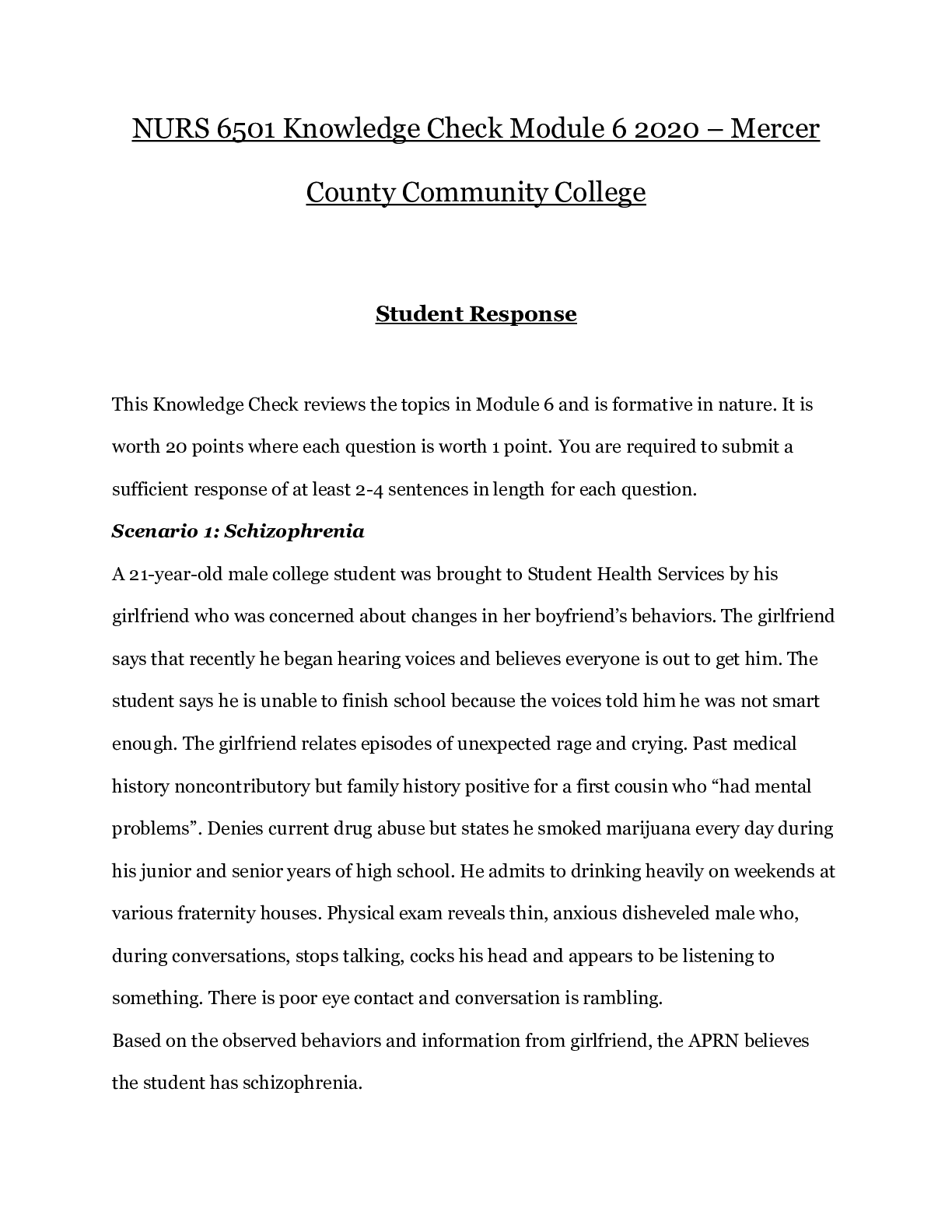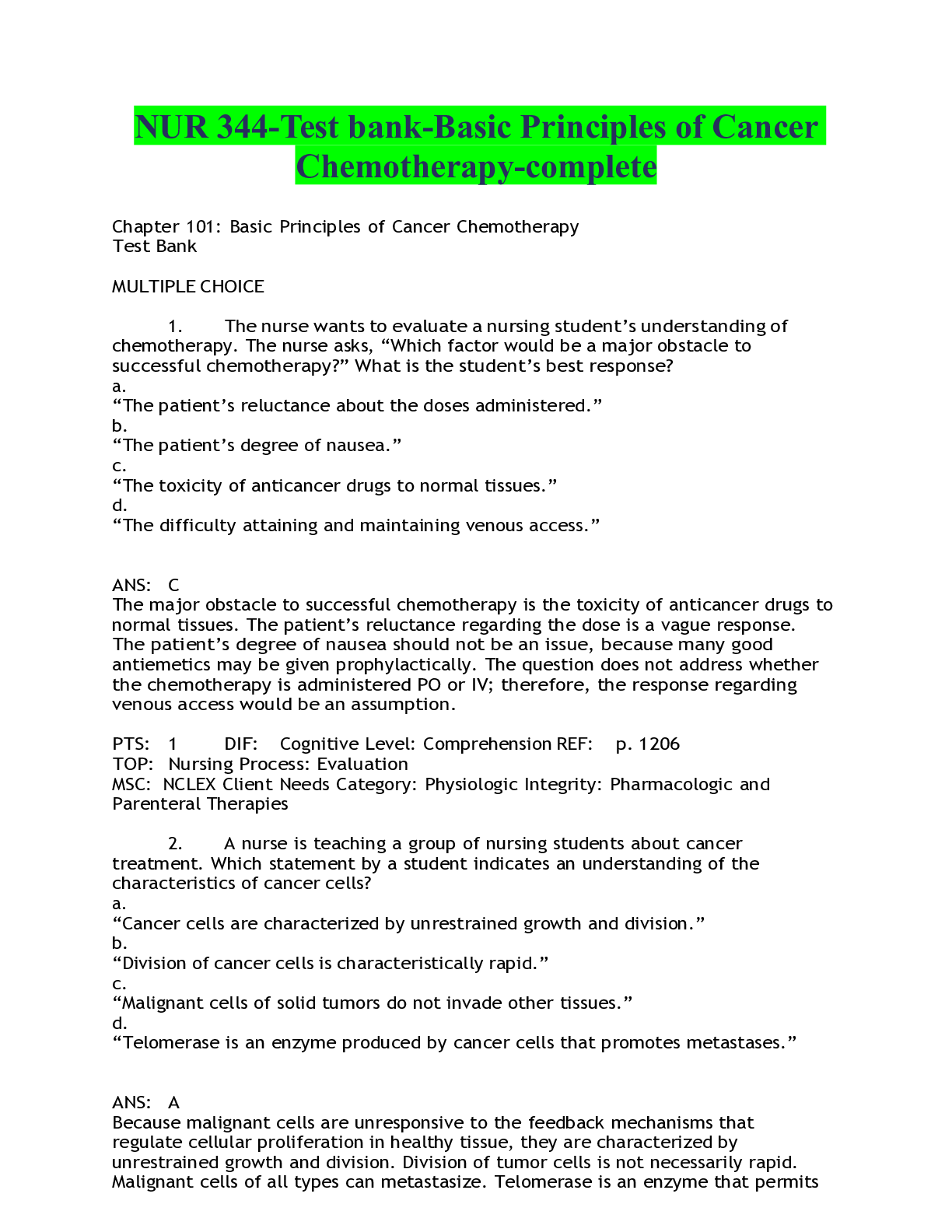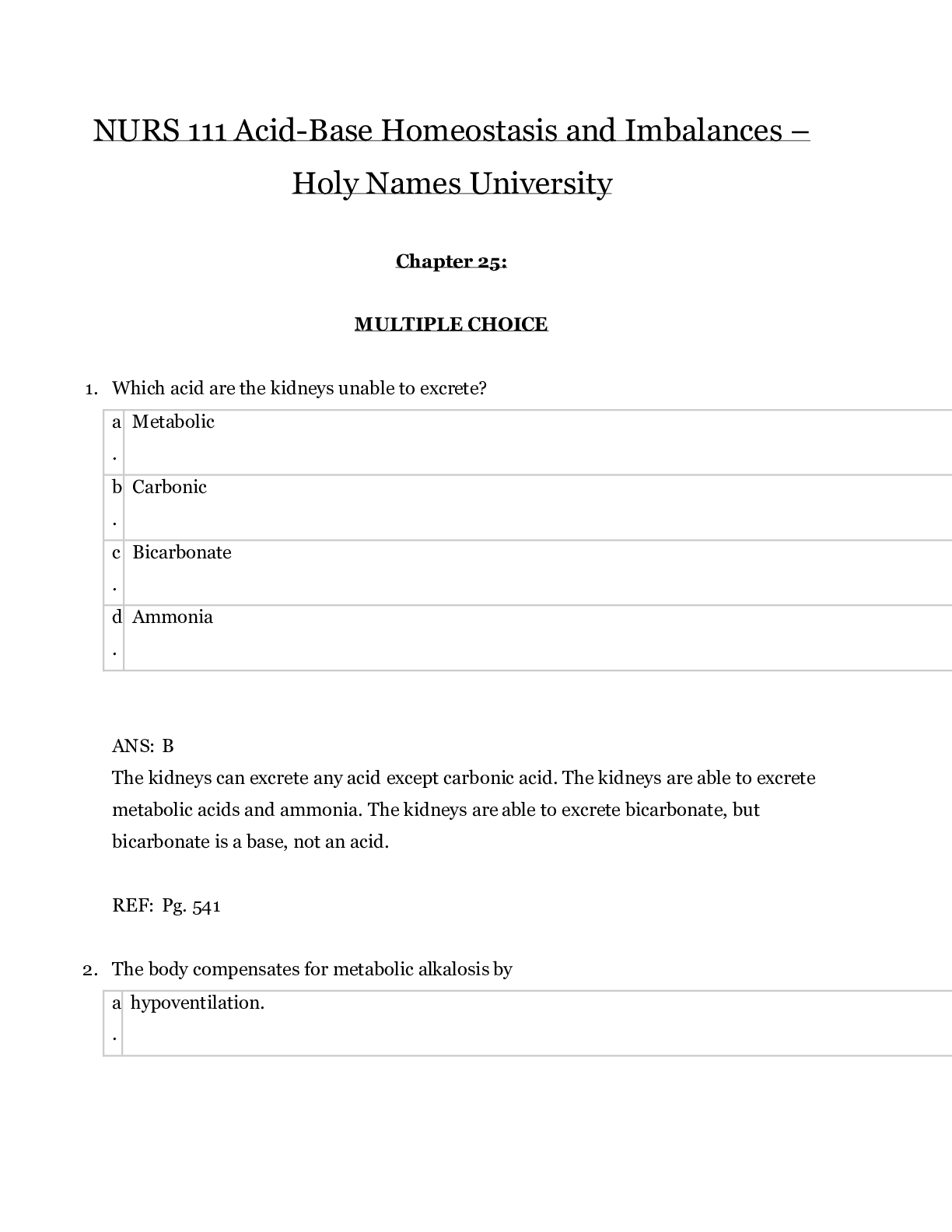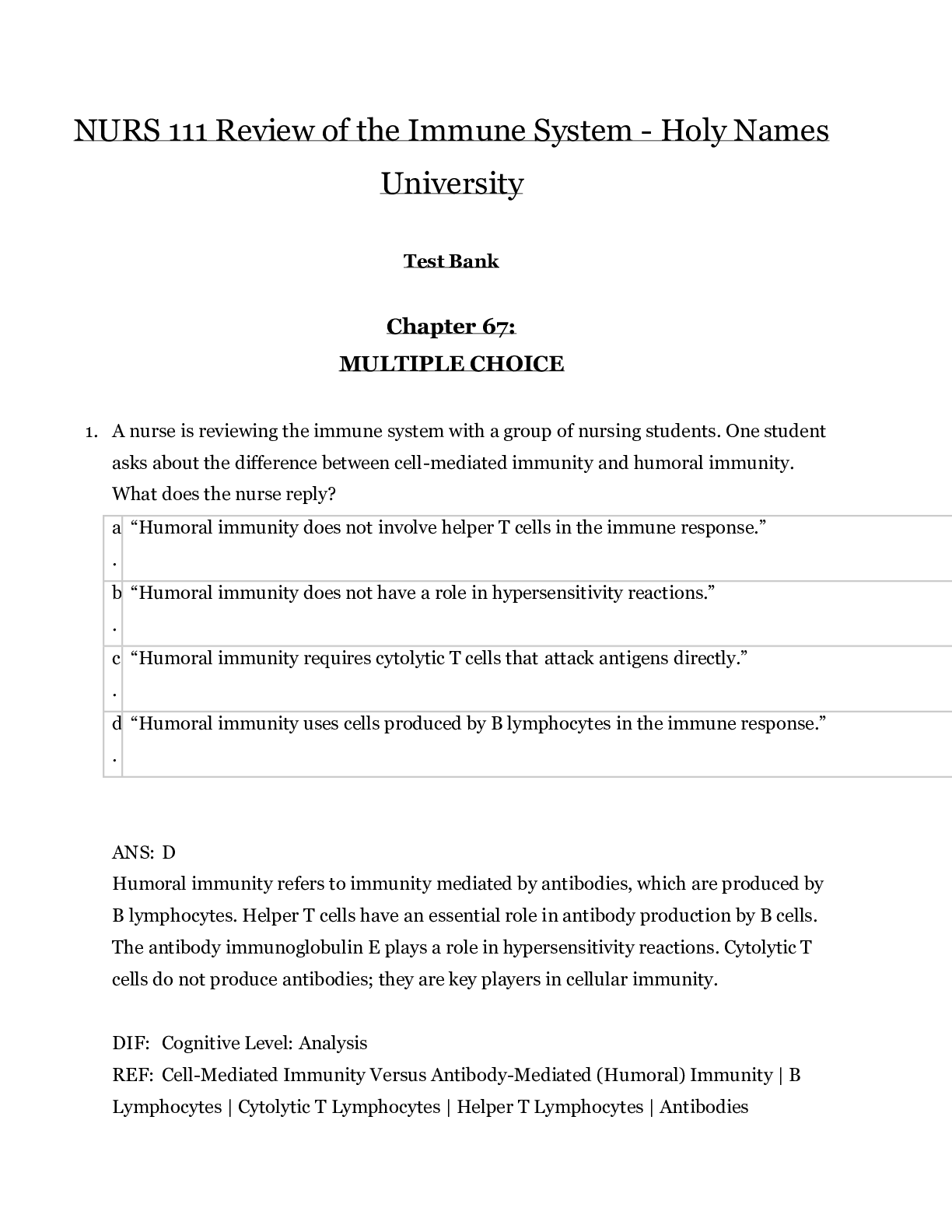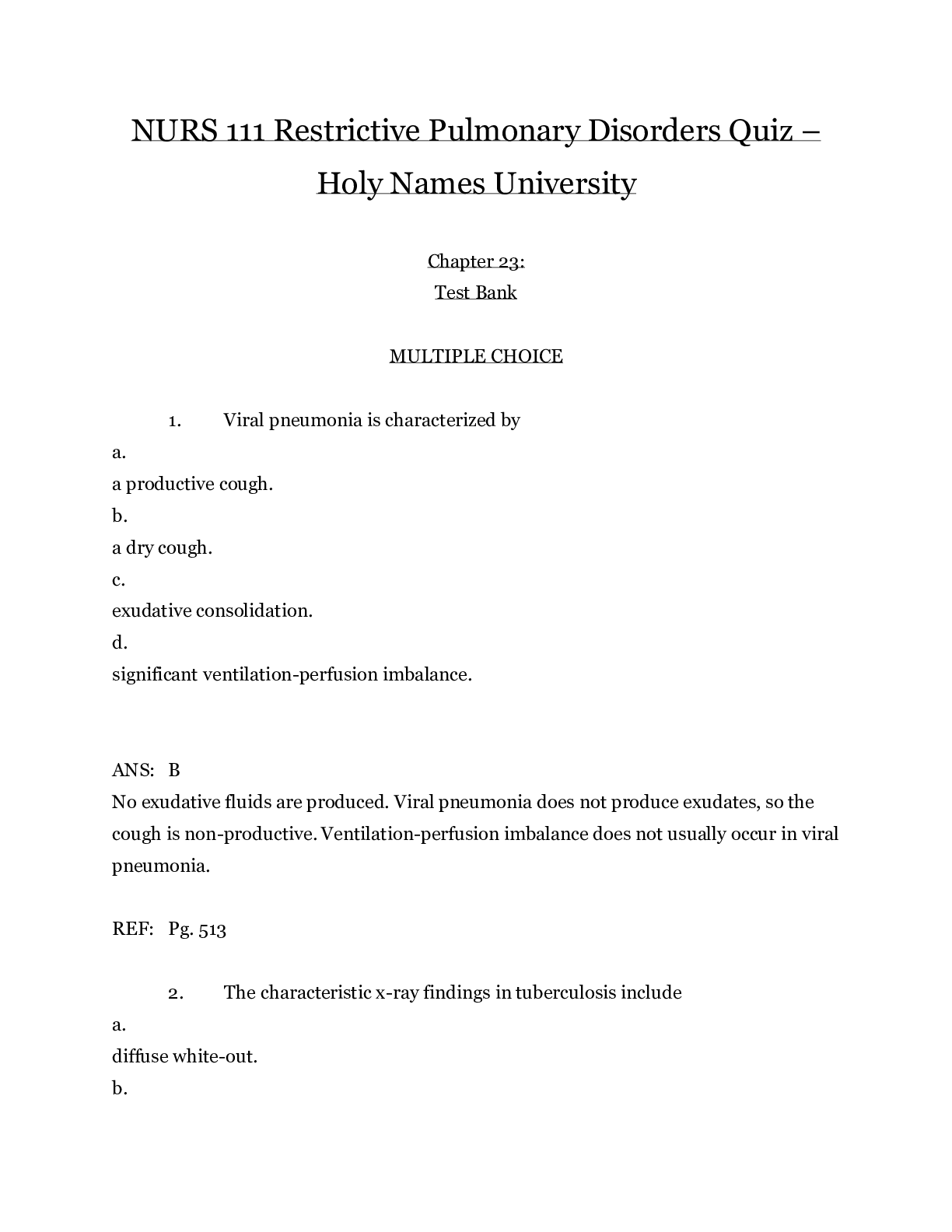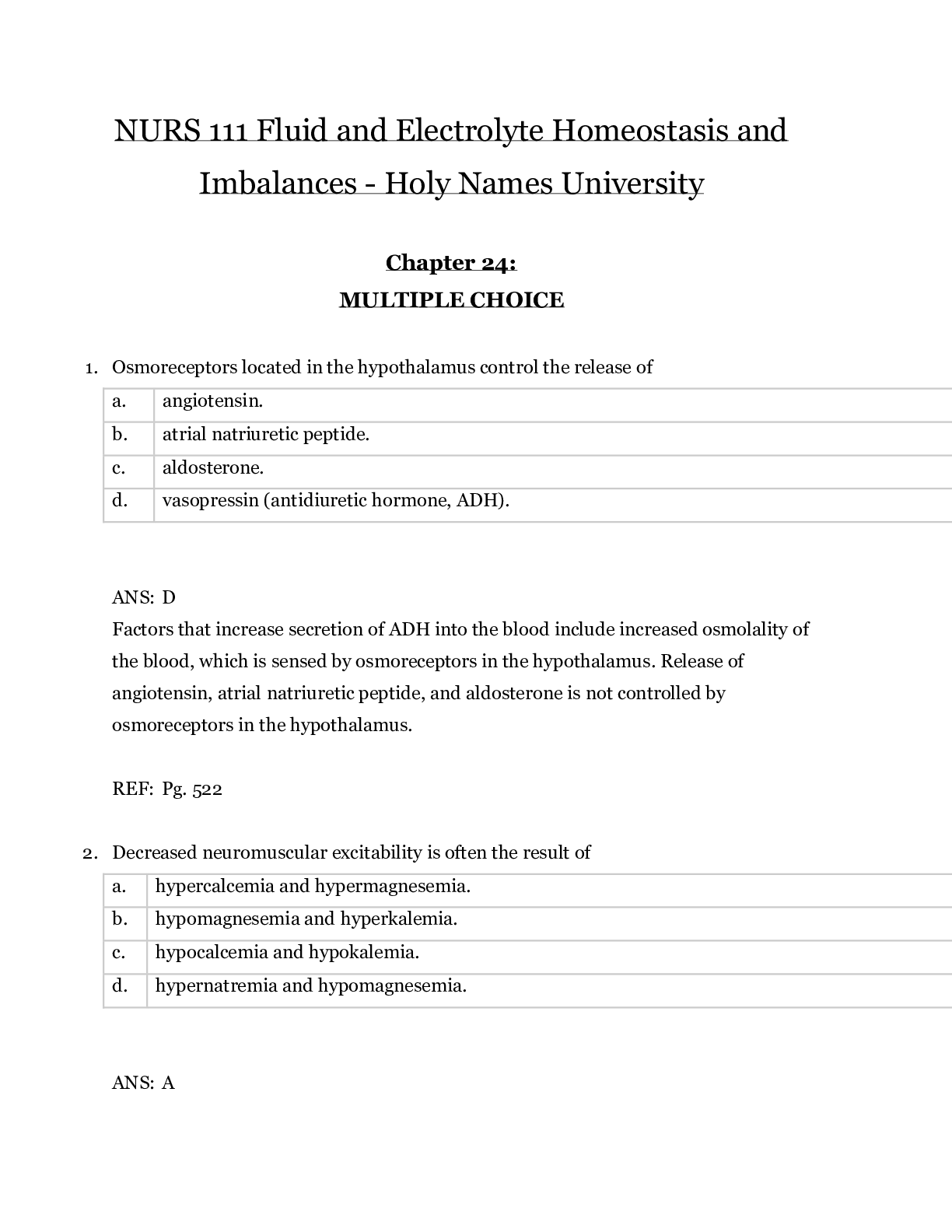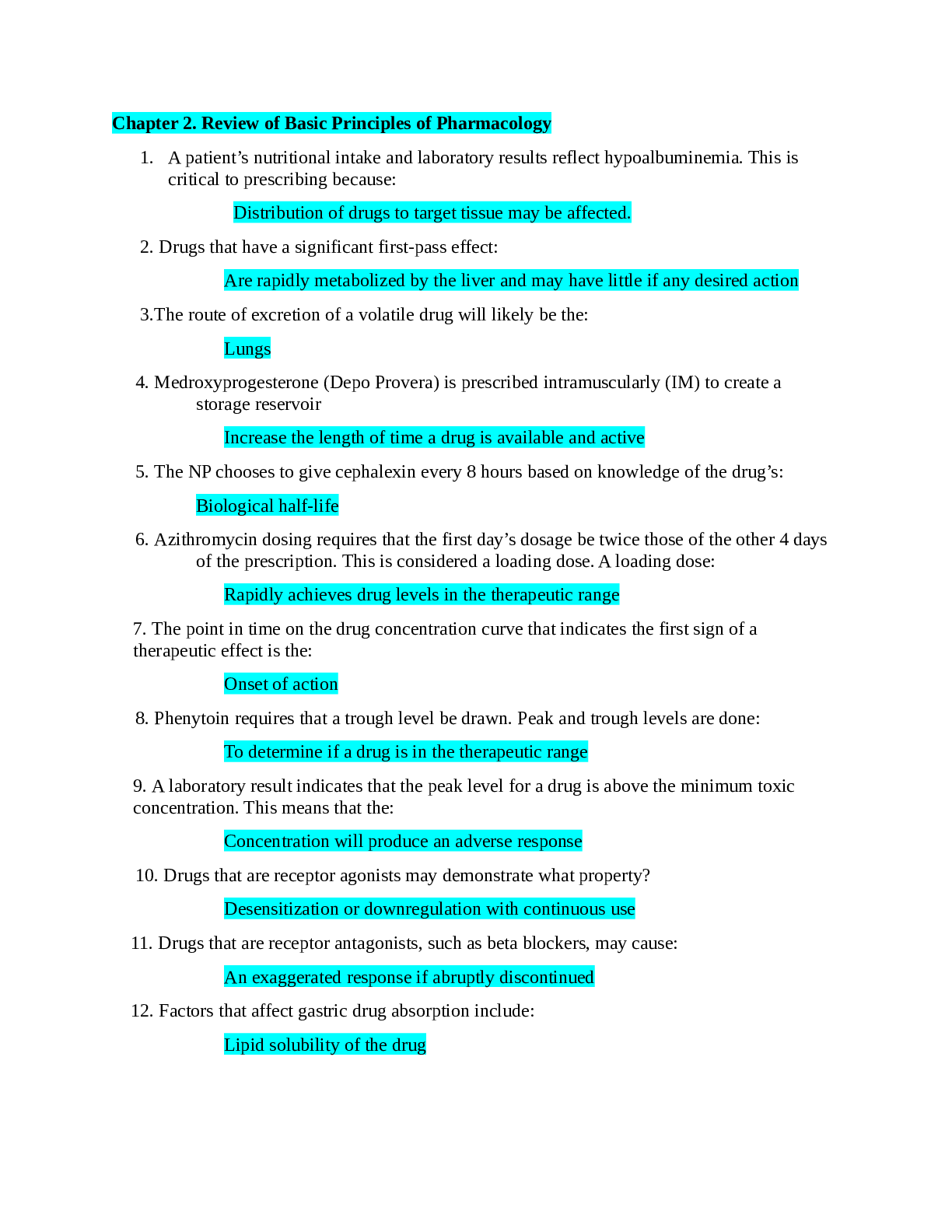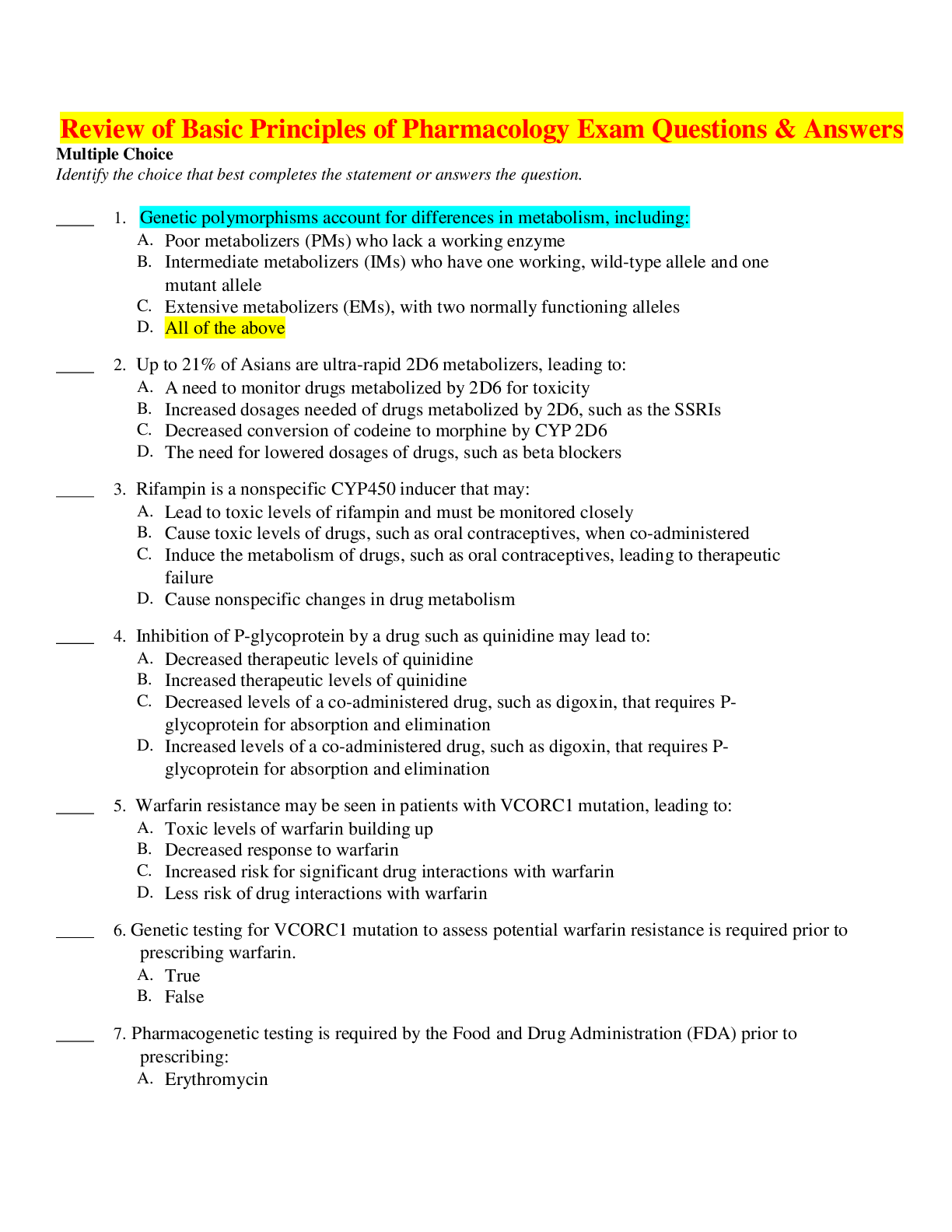*NURSING > EXAM > NURS 111 Basic Principles of Antimicrobial Therapy Quiz – Holy Names University | NURS111 Basic Pr (All)
NURS 111 Basic Principles of Antimicrobial Therapy Quiz – Holy Names University | NURS111 Basic Principles of Antimicrobial Therapy Quiz
Document Content and Description Below
NURS 111 Basic Principles of Antimicrobial Therapy Quiz – Holy Names University Chapter 83: Test Bank MULTIPLE CHOICE 1. The nurse has been caring for a patient who has been taking antibi... otics for 3 weeks. Upon assessing the patient, the nurse notices the individual has developed oral thrush. What describes the etiology of the thrush? a. Antibiotic resistance b. Community-acquired infection c. Nosocomial infection d. Suprainfection 2. The nurse is caring for a patient on a medical-surgical unit who has a fever of unknown origin. The prescriber has ordered a broad-spectrum antibiotic. Which intervention is the priority? a. Administering the antibiotic immediately b. Administering antipyretics as soon as possible c. Delaying administration of the antibiotic until the culture results are available d. Obtaining all cultures before the antibiotic is administered 3. The nurse is teaching a nursing student about the mechanism by which antimicrobial agents achieve selective toxicity. Which statement by the student indicates a need for further teaching? a. “Some agents disrupt the bacterial cell wall.” b. “Some agents act to block the conversion of para-aminobenzoic acid (PABA) to folic acid.” c. “Some agents cause phagocytosis of bacterial cells.” d. “Some agents weaken the cell wall, causing cell wall lysis.” 4. A child has received amoxicillin (Amoxil) for three previous ear infections, but a current otitis media episode is not responding to treatment. The nurse caring for this child suspects that resistance to the bacterial agent has occurred by which microbial mechanism? a. Alteration of drug target molecules b. Antagonist production c. Drug inactivation d. Reduction of drug concentration at the site of action 5. A nursing student asks a nurse to clarify the differences between the mechanisms of spontaneous mutation and conjugation in acquired resistance of microbes. What will the nurse say? a. Conjugation results in a gradual increase in resistance. b. Conjugation results in random changes in the microbe’s DNA. c. Spontaneous mutation leads to resistance to only one antimicrobial agent. d. Spontaneous mutation can transfer DNA from one organism to another. 6. A patient has a viral sinus infection, and the provider tells the patient that antibiotics will not be prescribed. The patient wants to take an antibiotic and asks the nurse what possible harm could occur by taking an antibiotic. Which response by the nurse is correct? a. “Antibiotics are mutagenic and can produce changes that cause resistance.” b. “Even normal flora can develop resistance and transfer this to pathogens.” c. “Host cells become resistant to antibiotics with repeated use.” d. “Patients who overuse antibiotics are more likely to have nosocomial infections.” 7. A patient with recurrent bacterial pneumonia is treated with an antibiotic that has worked previously but is not working to reduce symptoms in a current infection. The nurse caring for this patient understands that this is likely for which reason? a. The antibiotic altered the genetic makeup of the bacterial strain causing this infection. b. The antibiotic caused host cells to change and become more susceptible to bacterial effects. c. The antibiotic caused a mutation of the organism leading to reduced drug sensitivity. d. The antibiotic destroyed competing organisms that secrete substances toxic to the pathogen. 8. A patient has a localized skin infection, which is most likely caused by a gram-positive cocci. Until the culture and sensitivity results are available, the nurse will expect the provider to order a _____-spectrum _____ agent. a. broad; systemic b. broad; topical c. narrow; systemic d. narrow; topical 9. A parent asks a nurse if the provider will prescribe an antibiotic for a child who attends school with several children who have strep throat. The child is complaining of a sore throat and has a fever. What will be the nurse’s response? a. “Because strep throat is likely, your child should be treated empirically.” b. “With good hand washing, your child should not get strep throat.” c. “Your child probably has strep throat, so your provider will order an antibiotic.” d. “Your child should come to the clinic to have a throat culture done today.” 10. An older adult patient with chronic obstructive pulmonary disease (COPD) develops bronchitis. The patient has a temperature of 39.5° C. The nurse will expect the provider to: a. obtain a sputum culture and wait for the results before prescribing an antibiotic. b. order empiric antibiotics while waiting for sputum culture results. c. treat symptomatically, because antibiotics are usually ineffective against bronchitis. d. treat the patient with more than one antibiotic without obtaining cultures. MULTIPLE RESPONSE 1. Which methods have been identified for preventing antimicrobial resistance? (Select all that apply.) a. Administering influenza vaccine b. Stopping antibiotic therapy as soon as possible when treating infection c. Treating bacterial colonization in asymptomatic patients d. Using narrow-spectrum antibiotics when possible e. Using national data to determine antimicrobial drug selection 2. Which are benefits of using a combination of two or more antibiotics? (Select all that apply.) a. Reduced cost b. Reduced risk of suprainfection c. Reduced toxicity d. Reduced resistance e. Reduced risk in severe infection 3. The nurse is teaching a pharmacology refresher course to a group of nurses. A student asks what host factors affect the choice of agents in antimicrobial therapy. The nurse will tell the students that such host factors include what? (Select all that apply.) a. Age b. Gender c. Immune system status d. Infection site e. Weight [Show More]
Last updated: 1 year ago
Preview 1 out of 11 pages
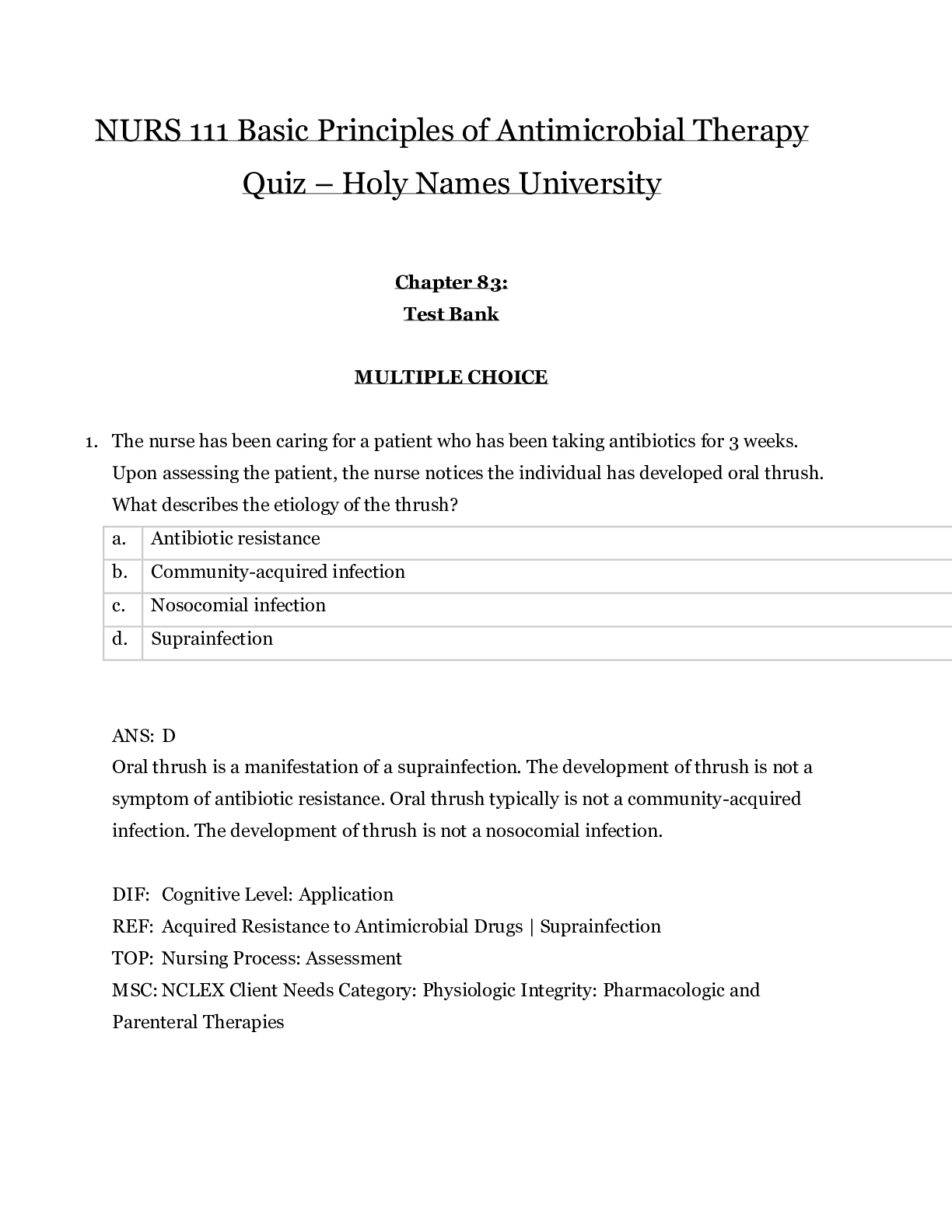
Reviews( 0 )
Document information
Connected school, study & course
About the document
Uploaded On
Oct 22, 2020
Number of pages
11
Written in
Additional information
This document has been written for:
Uploaded
Oct 22, 2020
Downloads
0
Views
30














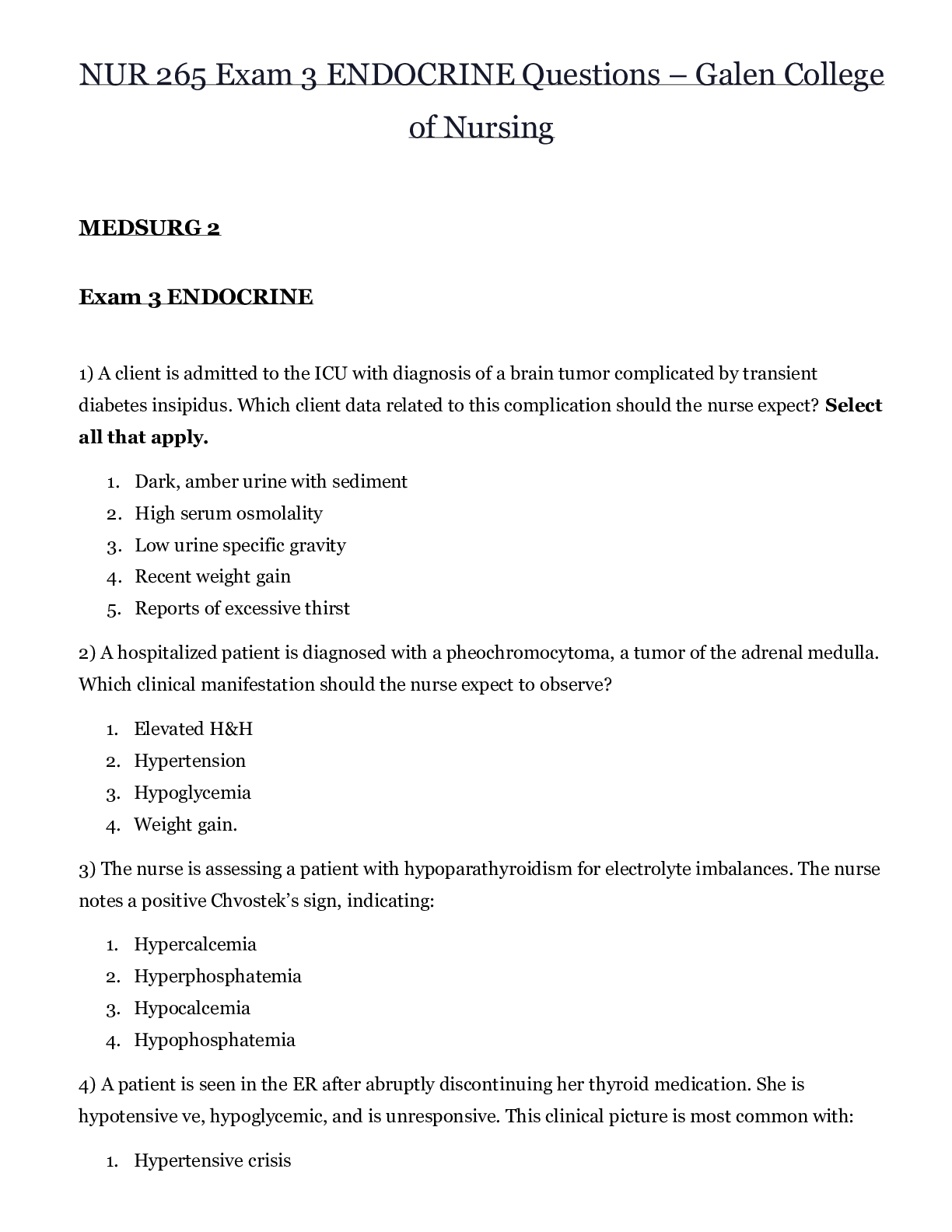
 – CHAMBERLAIN COLLEGE OF NURSING.png)
